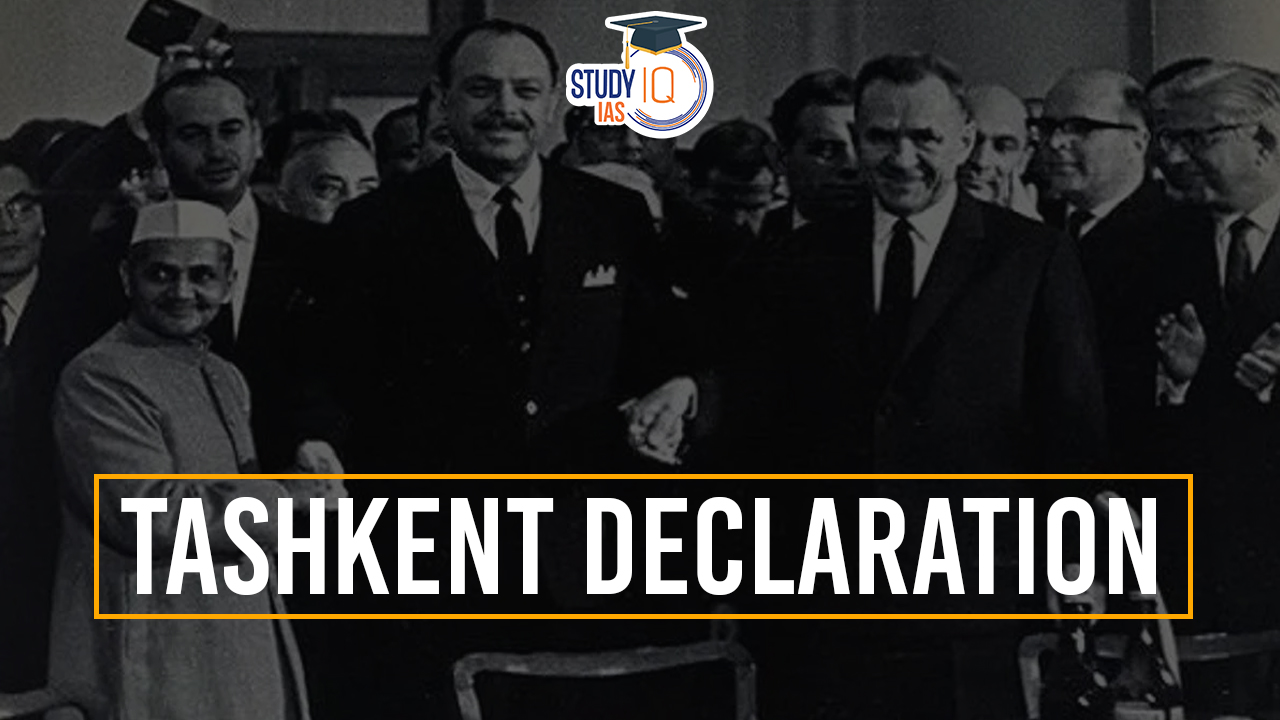Table of Contents
The Tashkent Declaration refers to a peace agreement signed between India and Pakistan on January 10, 1966, in Tashkent, the capital of the former Soviet Uzbekistan (now Uzbekistan). The declaration was the outcome of a summit held between Indian Prime Minister Lal Bahadur Shastri and Pakistani President Ayub Khan, mediated by Soviet Premier Alexei Kosygin.
We’re now on WhatsApp. Click to Join
What is Tashkent Declaration?
The Tashkent Declaration, signed to end the Indo-Pakistan war of 1965 (August 5, 1965 – September 23, 1965), marked a pivotal peace agreement between India and Pakistan. Concluded in Tashkent, the capital of Uzbekistan within the USSR, the primary objective was to rebuild economic and diplomatic ties between the two nations. The agreement emphasized non-interference in each other’s internal and external affairs and aimed at fostering bilateral relations for mutual progress and prosperity.
Tashkent Declaration Overview
| Tashkent Declaration Overview | |
| Date | January 10, 1966 |
| Location | Tashkent, Uzbekistan (USSR at the time) |
| Parties | India and Pakistan |
| Purpose | End the Indo-Pakistan War of 1965 |
| Key Points |
|
| Outcome | The agreement did little to ease the deep hostility between the two countries. Hostilities resumed in 1970. |
| Consequences | The Tashkent Declaration marked a temporary pause in hostilities but did not address the underlying issues, leading to renewed conflicts in 1970. |
Tashkent Declaration Background
- First Indo-Pakistani War (1947-1949): Fought post-independence, it led to a ceasefire, establishing the Line of Control (LOC) in Kashmir.
- Operation Gibraltar (April 1965): Pakistan’s failed attempt to capture Kashmir by inciting insurrection, dressed as locals.
- Indo-Pakistan War (August-September 1965): Triggered by Operation Gibraltar’s failure, risking involvement of Cold War superpowers.
- Diplomatic Intervention: The US and USSR diplomatically urged peace talks to resolve the conflict.
- UN Resolution (September 22, 1965): Ceasefire agreement following a UN resolution.
- Tashkent Declaration (January 1966): USSR-mediated peace talks between Lal Bahadur Shastri and Muhammad Ayub Khan aimed at lasting peace.
Salient Features of Tashkent Declaration
The Tashkent Declaration, a pivotal agreement between India and Pakistan, articulated several significant points to guide their post-conflict relationship:
- Restoration of Pre-War Positions: Both nations committed to a retreat to their respective positions before the outbreak of hostilities on August 5, 1965. This provision aimed at establishing a baseline for territorial boundaries and reducing tensions.
- Non-Interference in Internal Affairs: A crucial aspect of the declaration emphasized the principle of non-interference. Both countries pledged not to meddle in each other’s internal matters. Furthermore, they undertook to discourage any form of detrimental propaganda against one another, fostering an environment of mutual respect.
- Orderly Transfer of Prisoners of War: The Tashkent Declaration emphasized the need for a systematic repatriation process for prisoners of war. This provision sought to ensure a humane and organized return of individuals captured during the conflict.
- Leaders’ Commitment to Bilateral Improvement: The leaders of India and Pakistan, recognizing the importance of constructive dialogue, are committed to working towards the enhancement of bilateral relations. This included diplomatic efforts to rebuild trust and cooperation between the two nations.
- Trade and Economic Relations Restoration: An integral aspect of the agreement was the aim to restore trade and economic relations to their pre-war status. This provision sought to reestablish economic ties, promoting stability and shared prosperity.
The Tashkent Declaration, signed in the pursuit of lasting peace, encapsulated these detailed provisions, outlining a roadmap for the resolution of post-war issues and the promotion of amicable relations between India and Pakistan.
Outcome of Tashkent Declaration
The Tashkent Declaration refers to the agreement signed on January 10, 1966, in Tashkent, Uzbekistan, between India and Pakistan. The declaration followed the end of the Indo-Pakistani War of 1965. The conflict had arisen primarily over territorial disputes in the Kashmir region.
The key outcomes of the Tashkent Declaration include:
- Ceasefire: Both India and Pakistan agreed to an immediate ceasefire along the border, Line of Control, and the international border.
- Withdrawal of Forces: The agreement stipulated that both countries would withdraw their forces to positions held before August 5, 1965.
- No Use of Force: India and Pakistan pledged not to resort to the use of force and to settle their disputes through peaceful means.
- Respect for Sovereignty: The Tashkent Declaration emphasized the principle of respect for each other’s sovereignty and territorial integrity.
- Economic and Diplomatic Relations: The two nations agreed to restore economic and diplomatic relations.
- Prisoners of War: Both sides agreed to release and repatriate the prisoners of war.
Unfortunately, despite the Tashkent Declaration, the long-standing issues between India and Pakistan, particularly the Kashmir dispute, have persisted, leading to subsequent conflicts and tensions between the two countries over the years. The Tashkent Declaration, while providing a temporary resolution to the immediate conflict, did not lead to a lasting and comprehensive resolution of the underlying issues.
Tashkent Declaration UPSC
Tashkent Declaration, signed on January 10, 1966, aimed to end the 1965 Indo-Pak war. Key points included a ceasefire, withdrawal of forces, and a commitment to peaceful dispute resolution. Despite restoring economic and diplomatic ties, it failed to address deeper issues. Hostilities resumed in 1970, and the Kashmir dispute persists, underscoring the declaration’s temporary nature and its inability to ensure lasting peace between India and Pakistan.


 Rana Sanga: The Fearless Rajput King and...
Rana Sanga: The Fearless Rajput King and...
 Vikramshila University Revival, Location...
Vikramshila University Revival, Location...
 India-Canada Relations, Evolution, Recen...
India-Canada Relations, Evolution, Recen...





















